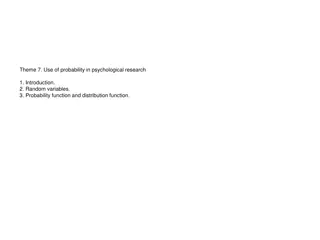Analyzing and Evaluating Psychological Concepts
This content provides a comprehensive guide on how to analyze, evaluate, explain, justify, and apply psychological concepts effectively. It covers examining in detail, comparing strengths and weaknesses, demonstrating knowledge, making judgments, and presenting clear accounts, supported by evidence. The content also discusses the implications of different viewpoints and the importance of considering diverse perspectives in psychological studies.
Download Presentation

Please find below an Image/Link to download the presentation.
The content on the website is provided AS IS for your information and personal use only. It may not be sold, licensed, or shared on other websites without obtaining consent from the author.If you encounter any issues during the download, it is possible that the publisher has removed the file from their server.
You are allowed to download the files provided on this website for personal or commercial use, subject to the condition that they are used lawfully. All files are the property of their respective owners.
The content on the website is provided AS IS for your information and personal use only. It may not be sold, licensed, or shared on other websites without obtaining consent from the author.
E N D
Presentation Transcript
HIGHER PSYCHOLOGY Command Words
ANALSYE Examine in detail in order to give a detailed account of the main feature of a concept, topic or issue including the relationship between the features; identify and compare strengths and weaknesses of the features. Explain why item is better or worse in comparison Discuss similarities and differences with different items What are the implications?
APPLY Make clear and appropriate use of detailed knowledge and understanding in order to make a considered judgement and demonstrate clear understanding of the concept, topic or issue.
DESCRIBE A straightforward but clear and detailed account of the main features of the concept, topic or issue.
EVALUATE Examine in detail in order to judge the value, quality and importance of an item in comparison with another. Identify strengths, weaknesses, similarities and differences and form a conclusion.
EXPLAIN Demonstrate detailed knowledge and understanding of the concept in the response using appropriate psychological terminology. Examples may be helpful to explain points.
JUSTIFY Give a reasoned and clear account, supported by evidence, of why a particular choice was made.
EVALUATE POINT EXAMPLE All participants were male Americans, so the result is not accurate to everyone.
One weakness of Aschs (1951) study was that it only measured the conformity rate of males. This meant that the results could not be generalised to the whole population as female conformity levels were not investigated. However, female conformity was explored in Mori and Arai s 2010 replication of Asch s study and found that females did conform to a similar extent to what Asch had found of men in his original study. Therefore Asch s study may have benefitted from both male and female participants.
EXPLAIN POINT EXAMPLE Those with high self-esteem are less likely to conform than those with low self-esteem.
One individual factor that influences conformity is personality. Santee and Maslach (1982) found that individuals with high self-esteem are less likely to conform than people with low self esteem. This suggests that people with high self- esteem feel less worried about the risk of ridicule from others if they decide not to conform as they are confident in both themselves and their answer. However, those with low self-esteem may feel pressure to conform as they lack confidence in themselves and don t want to have to defend answering differently than the group.
DESCRIBE POINT EXAMPLE Asch conducted a study on lines. The results were
Asch (1951) conducted a lab experiment in which the aim was to determine whether participants would conform to an unambiguous task (where the true answer could clearly be seen). The participants were 50 white, male, Americans. Participants were placed in a group with 7 other people. However, unknown to the one true participant, all 7 others were confederates (actors) who had been told to give specific wrong answers during 12 of 18 trials. The participant was asked to determine which line of 3 was the same length as one singular line an easy and clear question. However, the participant was placed second to last or last in the group and heard all of the confederates answer wrongly. For many participants this brought confusion and they may have conformed as they did not understand how they could be right. For others, they knew they were right but gave the wrong answer to avoid judgement from the group.
Asch (1951) conducted a lab experiment in which the aim was to determine whether participants would conform to an unambiguous task (where the true answer could clearly be seen). The participants were 50 white, male, Americans. Participants were placed in a group with 7 other people. However, unknown to the one true participant, all 7 others were confederates (actors) who had been told to give specific wrong answers during 12 of 18 trials. The participant was asked to determine which line of 3 was the same length as one singular line an easy and clear question. However, the participant was placed second to last or last in the group and heard all of the confederates answer wrongly. For many participants this brought confusion and they may have conformed as they did not understand how they could be right. For others, they knew they were right but gave the wrong answer to avoid judgement from the group.























